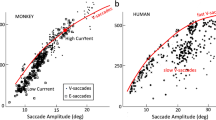Abstract
The deeper layers of the superior colliculus are involved in the initiation and execution of saccadic (high velocity) eye movements1. A large population of coarsely tuned collicular neurons is active before each saccade. The mechanisms by which the signals that precisely control the direction and amplitude of a saccade are extracted from the activity of the population are unknown. It has been assumed2–6 that the exact trajectory of a saccade is determined by the activity of the entire population and that information is not extracted from only the most active cells in the population at a subsequent stage of neural processing. The trajectory of a saccade could be based on vector summation of the movement tendencies provided by each member of the population of active neurons4 or be determined by a weighted average of the vector contributions of each neuron in the active population2. Here we present the results of experiments in which a small subset of the active population was reversibly deactivated with lidocaine. These results are consistent with the predictions of the latter population-averaging hypothesis and support the general idea that the direction, amplitude and velocity of saccadic eye movements are based on the responses of the entire population of cells active before a saccadic eye movement.
This is a preview of subscription content, access via your institution
Access options
Subscribe to this journal
Receive 51 print issues and online access
$199.00 per year
only $3.90 per issue
Buy this article
- Purchase on Springer Link
- Instant access to full article PDF
Prices may be subject to local taxes which are calculated during checkout
Similar content being viewed by others
References
Sparks, D. L. Physiol. Rev. 66, 118–171 (1986).
Sparks, D. L., Holland, R. & Guthrie, B. L. Brain Res. 113, 21–34 (1975).
McIlwain, J. T. Int. Rev. Physiol. 10, 223–248 (1976).
Van Gisbergen, J. A. M., Van Opstal, A. J. & Tax, A. A. M. Neuroscience 21, 541–555 (1987).
Deubel, H., Wolf, W. & Hauske, G. in Theoretical and Applied Aspects of Eye Movement Research (eds Gale, A. G. & Johnson, F.) 55–62 (Elsevier, Amsterdam, 1984).
Grossberg, S. & Kuperstein, M. Neural Dynamics of Adaptive Sensory-Motor Control: Ballistic Eye Movements (North-Holland, Amsterdam, 1986).
Wurtz, R. H. & Goldberg, M. E. J. Neurophysiol. 35, 575–586 (1972).
Schiller, P. H. & Stryker, M. J. Neurophysiol. 35, 915–924 (1972).
Robinson, D. A. Vision Res. 12, 1795–1808 (1972).
Sparks, D. L. Brain Res. 156, 1–16 (1978).
Hikosaka, O. & Wurtz, R. H. J. Neurophysiol. 53, 266–291 (1985).
Hikosaka, O. & Wurtz, R. H. Expl. Brain Res. 61, 531–539 (1986).
Berthoz, A., Grantyn, A. & Droulez, J. Neurosci. Lett. 72, 289–294 (1986).
Malpeli, J. G. & Schiller, P. H. J. Neurosc. Meth. 1, 143–151 (1979).
Fuchs, A. F. & Robinson, D. A. J. Appl. Physiol. 21, 1068–1070 (1966).
Author information
Authors and Affiliations
Rights and permissions
About this article
Cite this article
Lee, C., Rohrer, W. & Sparks, D. Population coding of saccadic eye movements by neurons in the superior colliculus. Nature 332, 357–360 (1988). https://doi.org/10.1038/332357a0
Received:
Accepted:
Issue Date:
DOI: https://doi.org/10.1038/332357a0
This article is cited by
-
Effects of others’ gaze and facial expression on an observer’s microsaccades and their association with ADHD tendencies
Journal of Physiological Anthropology (2023)
-
Express detection of visual objects by primate superior colliculus neurons
Scientific Reports (2023)
-
Neural encoding of instantaneous kinematics of eye-head gaze shifts in monkey superior Colliculus
Communications Biology (2023)
-
Superior colliculus saccade motor bursts do not dictate movement kinematics
Communications Biology (2022)
-
Loss of audiovisual facilitation with age occurs for vergence eye movements but not for saccades
Scientific Reports (2022)
Comments
By submitting a comment you agree to abide by our Terms and Community Guidelines. If you find something abusive or that does not comply with our terms or guidelines please flag it as inappropriate.



